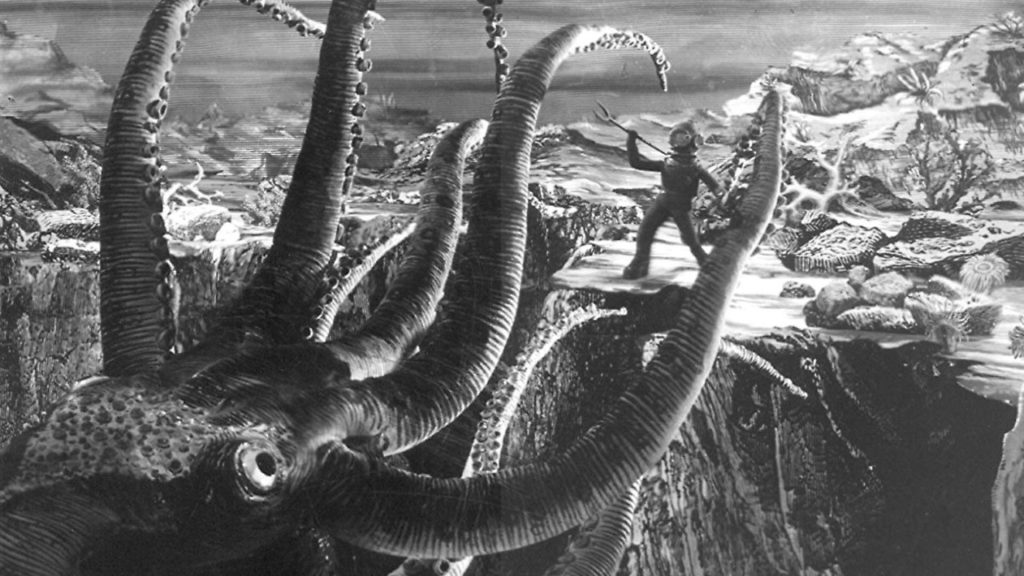
As two classic movies are released on DVD, JAMES OLIVER takes a turn through the strange world of communist science fiction and finds it every bit as political as its western counterpart.

Although science fiction is a genre that looks towards to the stars, its adherents (and sometimes practitioners too) can be oddly parochial in their outlook: you might think those who like stories which predict world government and intergalactic fellowship might be more willing to watch films with subtitles.
Especially since the English-speaking world has no monopoly on cinematic sci-fi. Indeed, some of the most sophisticated and intelligent offerings originated overseas, movies more interested in exploring ideas than blasting bug-eyed monsters.
In particular, it was a genre that flourished in those one-time communist countries. While the Soviet film industry is best known for stirring stories of proletarian struggle, it also produced science fiction that deserves to be as well known as the most famous work from the west.
In fact, the surprise is that they didn’t make much more. After all, Marxist-Leninism was a utopian project that aspired to forge a better future, and placed great emphasis on the necessity of technology – whether nuclear power or tractors – to do so.
As it was, Soviet nerds had to make do with quality rather than quantity. The first significant Russian science fiction film was made in 1924, a couple of years before Fritz Lang imagined the future in Metropolis (1927). Aelita Queen of Mars is very nearly as visually spectacular as that more celebrated film, with Martian society depicted with huge sets and eccentric costuming.
It concerns a (human) astronomer who day-dreams about life on Mars, and its beautiful queen Aelita (played by future director Yuliya Solntseva).
Much of the film is earthbound but when the astronomer finally nips over to the red planet, he finds a troubled place, with the lower orders cruelly enslaved (what can you expect from a monarchy, eh? Even an alien one.) One swift revolution later, all is resolved.
Cosmic Voyage (1936) is more impressive yet, envisaging a (surprisingly accurate) trip to the moon. It is a bold vision of communist futurism: set in 1946, it begins in a glorious Soviet city filled with tower blocks that look noticeably more appealing than those that would actually be built. Here we meet Professor Sedikh; he’s built a rocket (‘The Stalin’) and he means to use it.
The production was troubled: it was initiated as a silent film and had to be partially re-shot to accommodate sound. Moreover, the authorities took against the finished product, deciding that the shots of spacemen bouncing on the moon weren’t in the spirit of Soviet Realism: dreams of the future were subject to the politics of the present
As in the USA, though, the real science fiction boom came after the Second World War, reflecting new technologies and the slightly greater freedoms of the post-Stalin era. Not all those films were made in Russia. While the USSR’s subjugation of central and eastern Europe was a political tragedy, it was at least artistically fruitful; many of the best science fiction films that emerged from behind the Iron Curtain were made in those satellite states (a particularly apposite description in this context).
These films had a different emphasis than their American contemporaries. Western sci-fi of this time was generally an oblique expression of unease. Their rubbery monsters and alien invasions are easily mocked but they’re potent metaphors, for the terror of the bomb and, especially, defeat in the space race: much to Uncle Sam’s chagrin, the commie cosmonaut programme was more advanced than their own, hurling satellites, dogs and eventually men into the void way ahead of Nasa.
By contrast, Soviet science fiction was a much less fervid affair, celebrating the very achievements that terrified the Americans: films like I Was a Satellite of the Sun (1959) hymn the Soviet conquest of the heavens (and the sacrifices it required) with nary a little green man in sight.
Still, there’s at least one direct comparison to America’s atom-age nightmares and, happily, it’s one of the best. Invention for Destruction (1958) was directed by Karel Zeman, a Czechoslovak visionary, and derives from a novel by Jules Verne called Facing the Flag (1897). Zeman was not simply inspired by the story; he loved the original illustrations too, and sought to replicate them in his sets and costumes (right down to the wavy lines that characterise 19th century etching) so that the actors look to have walked into a picture.
There is more going on than the visuals, though. The villain – an aristocratic industrialist direct from communist central casting – has kidnapped the inventor of an ultimate weapon.
Verne’s novel was a general warning against military technology. Zeman makes it more specific; that ‘ultimate weapon’ is a thinly-disguised atomic bomb.
Unusually for a Czechoslovak film, Invention for Destruction was released in the west, albeit cut and dubbed, under the title The Fabulous World of Jules Verne. Nor was it alone: drive-in patrons who saw Voyage to the End of the Universe might not have realised it but they were watching something that, in its original form and under its original title of Ikarie XB-1 (1963), is one of the finest science fiction films – communist or otherwise – of its time.
Adapted from a novel by Polish science fiction specialist Stanislaw Lem, It is set aboard a spaceship on a 15 year mission to Alpha Centuri.
The crew will encounter many perilous events on their journey – mysterious vessels and black holes amongst them – but the emphasis is less on weird happenings than on the human cost of the mission. One officer, for example, was due to travel with his wife, until she became pregnant and was ordered to stay on Earth. He won’t see his daughter until she’s almost an adult. If he survives.
Stanislaw Lem’s humanistic science fiction would later inspire another director. Indeed, Solaris (1972) might be the most famous Soviet science fiction film of them all, even if it isn’t exactly typical: it is a slow, contemplative film as you would expect from Andrei Tarkovsky, Russian high-priest of the arthouses.
Tarkovsky was not much interested in convention; Solaris might be set on a space station (one orbiting a psychic planet) but this is very much a film about inner space and human feeling. Tarkovsky would later go even further with another, greater film. Stalker (1979) stretches the very limits of the genre, a metaphysical exploration pretty much the antithesis of its near-contemporary Star Wars (1977).
Such films were only possible in a film industry that enjoyed generous subsidy from the state; once Marxist-Leninism collapsed, that funding did too, one of the few downsides to the revolutions of 1989.
Still, while most Russian science fiction is of limited interest – Matrix rip-offs like Night Watch (Timur Bekmambetov, 2004) – the occasional oddity still sneaks through, like the gloriously bonkers Hard To Be A God (2013): it is set in the filth and decay of the middle ages… but the middle ages of another planet, being observed by scientists from ours.
It is worth remembering these films and not just for their quality. We are on the verge of another space race: the Chinese rover currently exploring the dark side of the Moon is only the beginning of the People’s Republic’s astronautic ambitions. We should be alert for a boom in Chinese sci-fi, not to mention American responses: keep watching the skies!
Cosmic Voyage has just been released on DVD on Edition Filmmuseum (Germany); while Invention For Destruction is now available on DVD from Second Run (UK), which has also released Ikarie XB-1
Stanislaw Lem
When the Polish author died in 2006, aged 84, he was described as possibly the most popular and widely read science fiction writer in the world. His books have been translated into at least 40 languages and more than 45 million copies have been sold.
His most famous work is Solaris, published in 1961 and made into a movie by Tarkovsky a decade later. A Hollywood version followed in 2002, starring George Clooney and Natascha McElhone.
Lem was born in 1921 in Lviv, then a Polish city but now part of Ukraine. He studied medicine there before the Second World War.
During the Nazi occupation, Lem’s family, which had Jewish roots, avoided imprisonment in a ghetto, surviving with false papers. Lem gave up his studies and found a job as a mechanic, servicing, repairing and subtly sabotaging the Germans’ vehicles.
Lem never qualified as a doctor and in 1946 he moved to Krakow as he embarked on a career as a writer. He concentrated on science fiction, a genre regarded by Poland’s communist regime as fairly harmless in terms of censorship. However, his first major novel, Hospital of the Transfiguration, went unpublished for eight years until the ideological thaw that followed Stalin’s death in 1953.
After the collapse of communism in eastern Europe, Lem turned to writing reports on future trends, including computer crime and the ethical problems of the internet.









